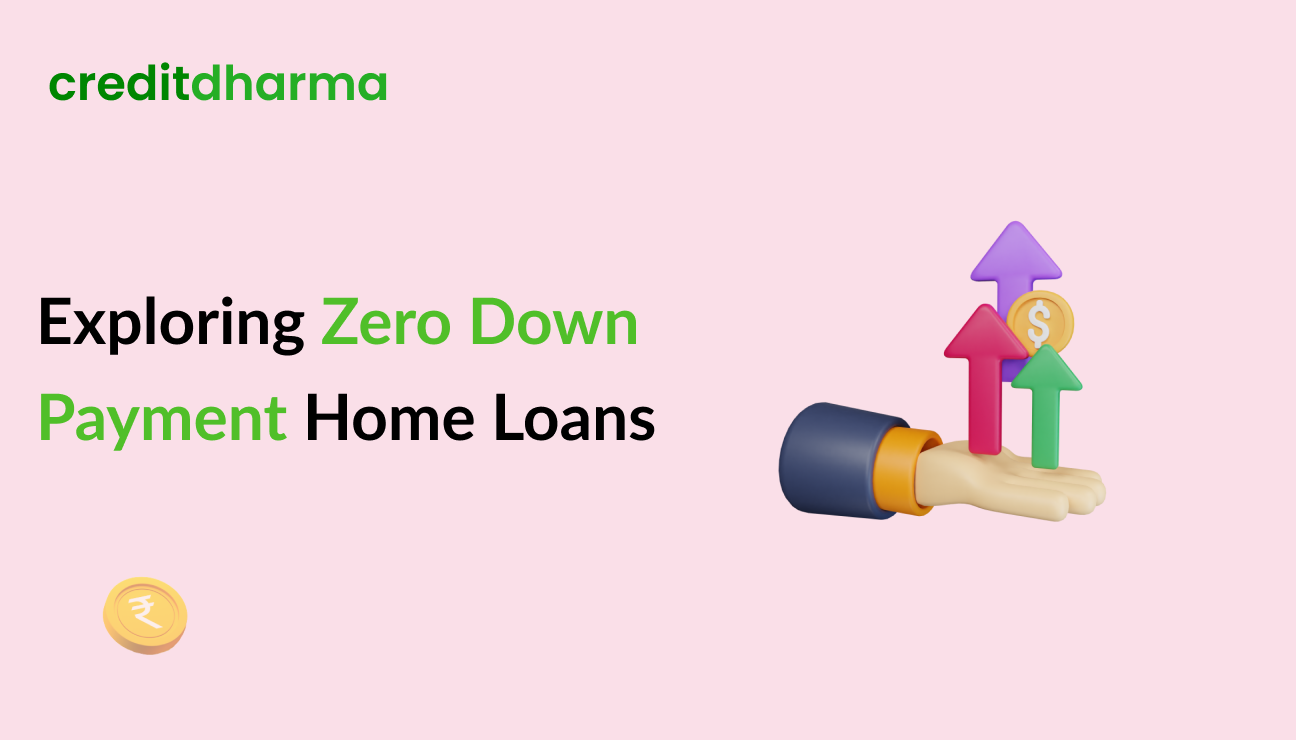Buying a home is one of the most significant financial milestones for many Indians. While home loans have made homeownership more accessible, the challenge of arranging a 10%-20% down payment remains a hurdle for many. But what if you could buy your dream home without paying anything upfront?
Welcome to the world of zero down payment home loans—a concept gaining traction in India. In this guide, we’ll break down everything you need to know about these loans, using practical examples, actionable tips, and clear numbers to help you make informed decisions

Own Your Dream Home with Zero Downpayment – Only with Credit Dharma!
What are Zero Downpayment Home Loans?
In a typical home loan scenario, Indian banks finance 80%-90% of the property’s value, leaving you to cover the remaining 10%-20% as a down payment. For example:
- For a property worth ₹50 lakh, you’d need to arrange ₹5-10 lakh upfront as a down payment.
A zero down payment loan, however, covers the entire cost of the property. You don’t need to shell out any money upfront—the full amount is financed by the lender.
Check Out: How to Save for Your Home Loan Downpayment?
Are Zero Down Payment Loans Available in India?
In India, true zero down payment loans are rare but achievable through creative solutions:
- Builder Subvention Schemes: Builders partner with banks to offer 100% financing.
- Top-Up Loans: You take an unsecured loan to cover the down payment.
- Employer Loans: Some organizations offer full-financing support for employees.
Why Should You Consider Zero Down Payment Loans?
Imagine this scenario: You’ve found the perfect ₹60 lakh apartment in Pune. But your savings are only ₹2 lakh—far below the ₹6-12 lakh required for a traditional down payment. A zero down payment option allows you to move forward without waiting for years to save.
This can be especially helpful if:
- You’re a first-time buyer with limited savings.
- You’re buying in a rapidly appreciating market and don’t want to delay.
- You have a stable income but haven’t built a large financial cushion yet.
How To Arrange Funds for a Zero Down Payment Loan
If you’re worried about financing a property without a traditional down payment, here are some strategies to consider:
1. Take a Personal Loan
Example: For a ₹40 lakh property, if you secure a ₹36 lakh home loan (90%), the remaining ₹4 lakh can come from a personal loan.
- Interest Rates: Personal loans in India typically range from 10%-15% interest—higher than home loans but faster to approve.
- Tip: This is a good option if your credit score is above 750, as lenders may offer better rates.
2. Leverage Government Schemes like PMAY
What’s PMAY? The Pradhan Mantri Awas Yojana provides up to 6.5% interest subsidy for eligible homebuyers, reducing your loan burden.
- How It Helps: The subsidy reduces your monthly EMI, freeing up cash for the down payment.
- Eligibility: Check your income bracket and whether your property is in an approved location.
3. Use Investments as Collateral
Example: If you have ₹5 lakh in FDs, you can use them as collateral to get a secured loan for your down payment.
- Why It Works: Secured loans typically have lower interest rates (8%-10%) compared to personal loans.
- Tip: Ensure the returns on your investments are lower than the loan interest to make this option worthwhile.
4. Borrow from Friends or Family
Example: For a ₹50 lakh home, borrowing ₹5 lakh from family can save you from taking a high-interest personal loan.
- Benefit: No interest or penalties, and repayment terms can be flexible.
- Tip: Be transparent about repayment timelines to maintain trust.
5. Employer Loans
Example: Tech companies like TCS and Infosys often offer employee loans for housing with competitive interest rates.
- Benefit: Minimal documentation, low interest, and easy repayment through salary deductions.
- Tip: Check your eligibility based on tenure and employer policies.
Also Read: Home Loans in Bangalore
Pros and Cons of Zero Down Payment Loans
| Cons | Details |
|---|---|
| Stricter Eligibility | Banks prefer applicants with strong credit profiles (750+ scores). |
| Higher Loan Amounts | Financing 100% means larger EMIs and higher interest payments. |
| Example | For a ₹50 lakh loan at 8.5% for 20 years: – Zero down payment EMI: ₹43,045. – With 20% down payment (₹10 lakh), EMI: ₹34,436. |
| Higher Interest Costs | More borrowed capital results in increased interest payments over time. |
Get a Home Loan
with Highest Eligibility
& Best Rates

A Case Study for Zero Down Payment Home Loans
Neha, a school teacher in Bengaluru, found a cozy ₹45 lakh apartment but lacked the ₹9 lakh down payment required. Here’s how she managed:
- Used PMAY Subsidy: Neha qualified for a ₹2.3 lakh subsidy, reducing her loan amount.
- Took a ₹3 lakh Personal Loan: With her credit score of 780, she secured an interest rate of 11%.
- Borrowed ₹4 lakh from Parents: This interest-free loan helped bridge the gap.
Outcome: Neha became a homeowner with manageable EMIs of ₹38,500/month and preserved her emergency savings.
Suggested Read: Subvention Scheme for Homebuyers

Are you looking for lower interest rate home loan balance transfer?
Top Tips for Zero Down Payment Borrowers
- Build Your Credit Score: Aim for 750+ to unlock better rates.
- Compare Lenders: Some banks offer builder subvention schemes, which can be advantageous.
- Understand Hidden Costs: Watch for charges like processing fees, stamp duty, and GST.
- Prepare for Higher EMIs: Ensure your monthly income comfortably covers 50%-60% of all debt payments.
Also Read: Ideal Credit Score for Home Loans
Get the Best Home Loan Offers with Credit Dharma
Credit Dharma is your trusted partner for securing the best Home Loan offers, with over ₹500 Cr+ loans handled and partnerships with 20+ leading banks. We provide exclusive access to the lowest interest rates and a seamless, digital process with fast approvals in just 1-2 weeks, backed by lifetime support from our home loan experts.
Why choose Credit Dharma? We provide:
- Lowest Interest Rates: Save more with every EMI.
- Maximum Funding: Get up to 100% funding for your dream home.
- Simple & Digital Process: No tedious paperwork or branch visits.
- Expert Guidance: Lifetime support from our team of specialists.
Compare, choose, and secure the best Home Loan offer with Credit Dharma — your home loan journey starts here!
Conclusion
Zero down payment home loans are a game-changer for Indian homebuyers with limited savings. While they come with higher costs and risks, they can be a viable solution when approached strategically. By leveraging government schemes, personal loans, or employer support, you can turn your dream of homeownership into reality without waiting years to save for a down payment.
Remember, the key is to assess your financial stability, calculate your repayment capacity, and choose the option that best aligns with your long-term goals. Happy house hunting!
Frequently Asked Questions
A zero downpayment home loan allows borrowers to finance 100% of the home’s purchase price, eliminating the need for an upfront down payment.
To qualify, you typically need a good credit score, stable employment history, and sufficient income to cover the mortgage payments. Lenders may also consider your debt-to-income ratio and other financial factors.
While zero down payment options are available for various types of properties, including single-family homes, condos, and townhouses, eligibility may vary depending on the lender and the specific loan program.

